Hello, iOS – Quickstart
Warning
The iOS Designer was deprecated in Visual Studio 2019 version 16.8 and Visual Studio 2019 for Mac version 8.8, and removed in Visual Studio 2019 version 16.9 and Visual Studio for Mac version 8.9. The recommended way to build iOS user interfaces is directly on a Mac running Xcode's Interface Builder. For more information, see Designing user interfaces with Xcode.
This guide describes how to create an application that translates an alphanumeric phone number entered by the user into a numeric phone number, and then calls that number. The final application looks like this:
Requirements
iOS development with Xamarin requires:
- A Mac running macOS High Sierra (10.13) or above.
- Latest version of Xcode and iOS SDK installed from the App Store .
Xamarin.iOS works with the following setup:
- Latest version of Visual Studio for Mac that fits the above specifications.
The Xamarin.iOS Mac Installation guide is available for step-by-step installation instructions
Xamarin.iOS works with the following setup:
- Latest version of Visual Studio 2019 or Visual Studio 2017 Community, Professional, or Enterprise on Windows 10, paired with a Mac build host that fits the above specifications.
The Xamarin.iOS Windows Installation guide is available for step-by-step installation instructions.
Before getting started, download the Xamarin App Icons set.
Visual Studio for Mac Walkthrough
This walkthrough describes how to create an application called Phoneword that translates an alphanumeric phone number into a numeric phone number.
Launch Visual Studio for Mac from the Applications folder or Spotlight:
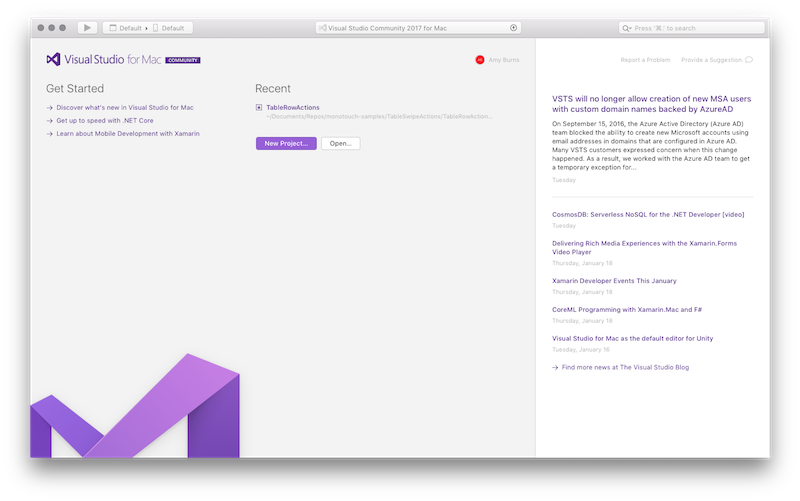
On the Launch Screen, click New Project... to create a new Xamarin.iOS solution:

From the New Solution dialog, choose the iOS > App > Single View Application template, ensuring that C# is selected. Click Next:
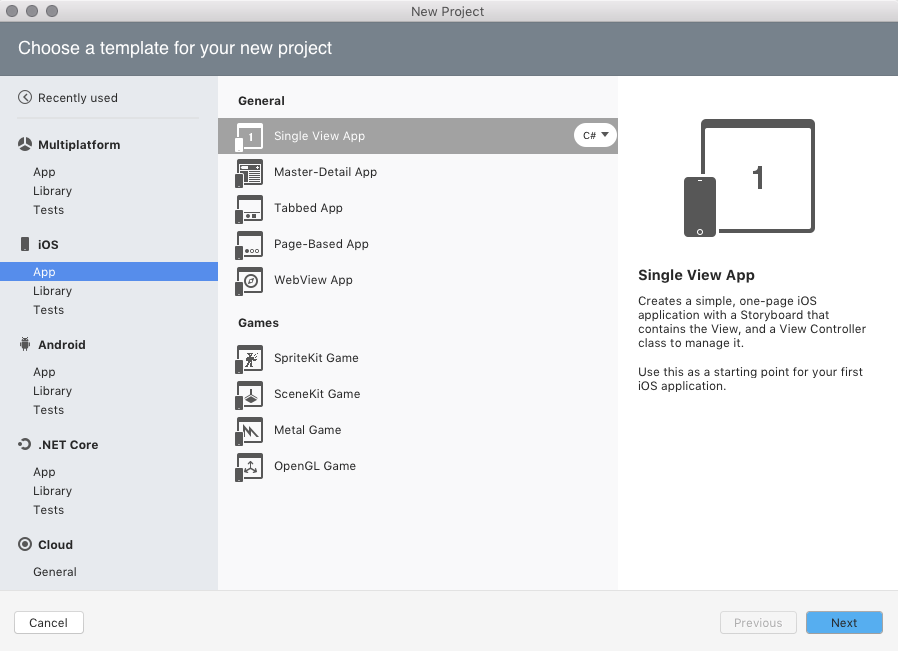
Configure the app. Give it the Name
Phoneword_iOS, and leave everything else as default. Click Next: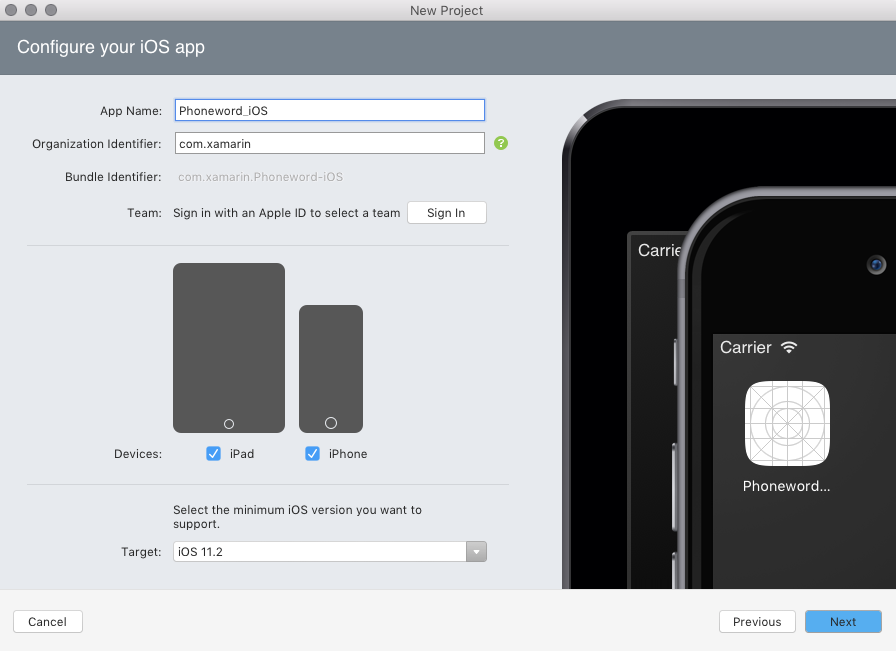
Leave the Project and Solution Name as is. Choose the location of the project here, or keep it as the default:
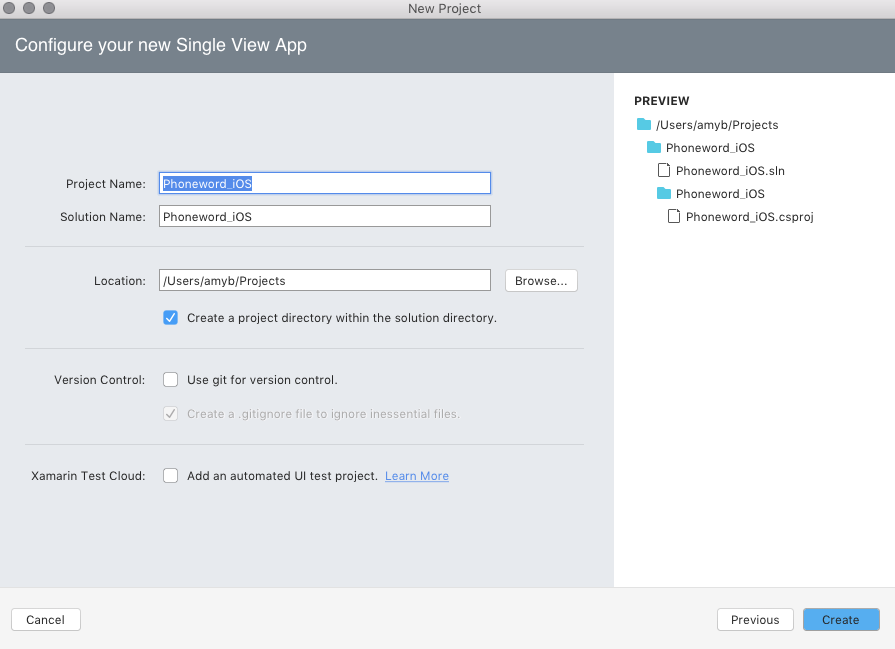
Click Create to make the Solution.
Open the Main.storyboard file by double-clicking on it in the Solution Pad. Ensure you open the file using the Visual Studio iOS Designer (right click the storyboard and select Open With > iOS Designer). This provides a way to visually to create a UI:
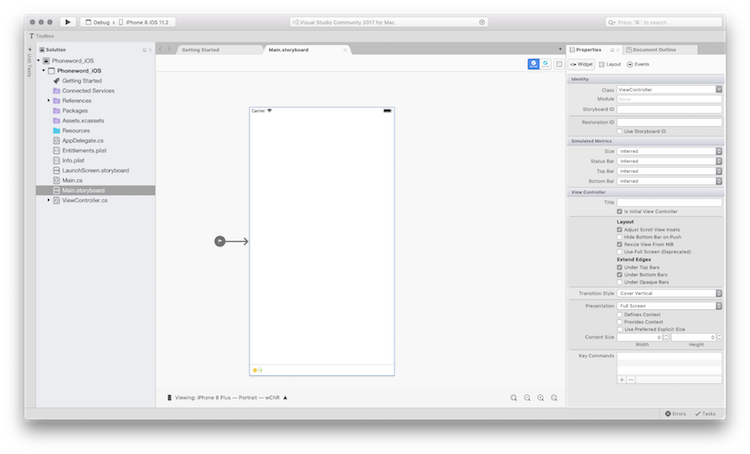
Note that size classes are enabled by default. Refer to the Unified Storyboards guide to learn more about them.
In the Toolbox Pad, type "label" into the search bar and drag a Label onto the design surface (the area in the center):
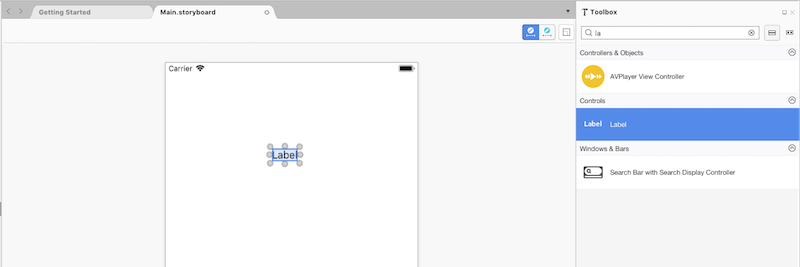
Note
You can bring up the Properties Pad or Toolbox at any time by navigating to View > Pads.
Grab the handles of the Dragging Controls (the circles around the control) and make the label wider:

With the Label selected on the design surface, use the Properties Pad to change the Text property of the Label to "Enter a Phoneword:"

Search for “text field” inside the Toolbox and drag a Text Field from the Toolbox onto the design surface and place it under the Label. Adjust the width until the Text Field is the same width as the Label:
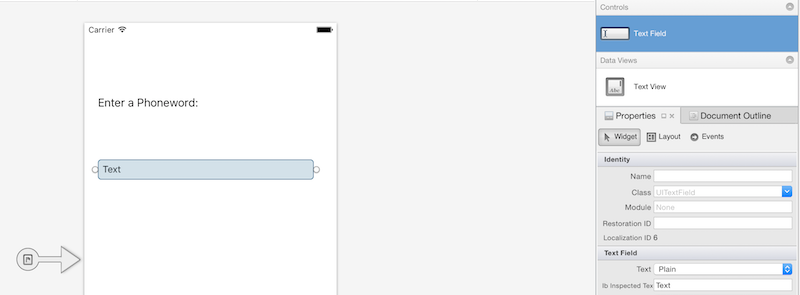
With the Text Field selected on the design surface, change the Text Field’s Name property in the Identity section of the Properties Pad to
PhoneNumberText, and change the Text property to "1-855-XAMARIN":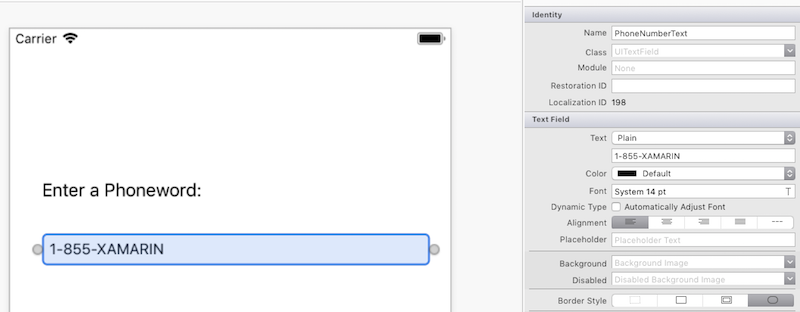
Drag a Button from the Toolbox onto the design surface and place it under the Text Field. Adjust the width so the Button is as wide as the Text Field and Label:
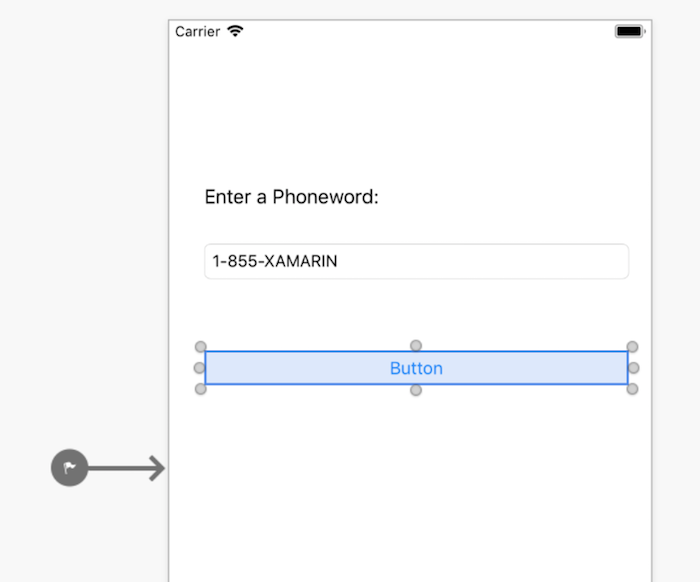
With the Button selected on the design surface, change the Name property in the Identity section of the Properties Pad to
TranslateButton. Change the Title property to "Translate":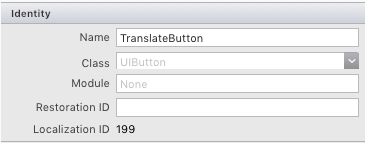
Repeat the two steps above and drag a Button from the Toolbox onto the design surface and place it under the first Button. Adjust the width so the Button is as wide as the first Button:

With the second Button selected on the design surface, change the Name property in the Identity section of the Properties Pad to
CallButton. Change the Title property to "Call":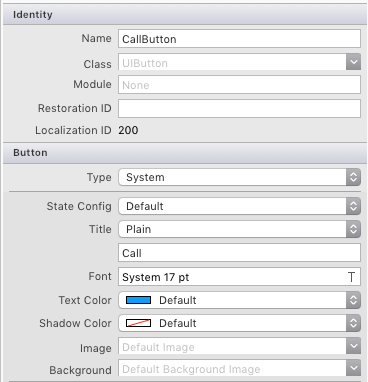
Save the changes by navigating to File > Save or by pressing ⌘ + s.
Some logic needs to be added to the app to translate phone numbers from alphanumeric to numeric. Add a new file to the Project by right clicking on the Phoneword_iOS Project in the Solution Pad and choosing Add > New File... or pressing ⌘ + n:

In the New File dialog, select General > Empty Class and name the new file
PhoneTranslator:
This creates a new, empty C# class for us. Remove all the template code and replace it with the following code:
using System.Text; using System; namespace Phoneword_iOS { public static class PhoneTranslator { public static string ToNumber(string raw) { if (string.IsNullOrWhiteSpace(raw)) { return ""; } else { raw = raw.ToUpperInvariant(); } var newNumber = new StringBuilder(); foreach (var c in raw) { if (" -0123456789".Contains(c)) { newNumber.Append(c); } else { var result = TranslateToNumber(c); if (result != null) { newNumber.Append(result); } } // otherwise we've skipped a non-numeric char } return newNumber.ToString(); } static bool Contains (this string keyString, char c) { return keyString.IndexOf(c) >= 0; } static int? TranslateToNumber(char c) { if ("ABC".Contains(c)) { return 2; } else if ("DEF".Contains(c)) { return 3; } else if ("GHI".Contains(c)) { return 4; } else if ("JKL".Contains(c)) { return 5; } else if ("MNO".Contains(c)) { return 6; } else if ("PQRS".Contains(c)) { return 7; } else if ("TUV".Contains(c)) { return 8; } else if ("WXYZ".Contains(c)) { return 9; } return null; } } }Save the PhoneTranslator.cs file and close it.
Add code to wire up the user interface. To do this double-click on ViewController.cs in the Solution Pad to open it:
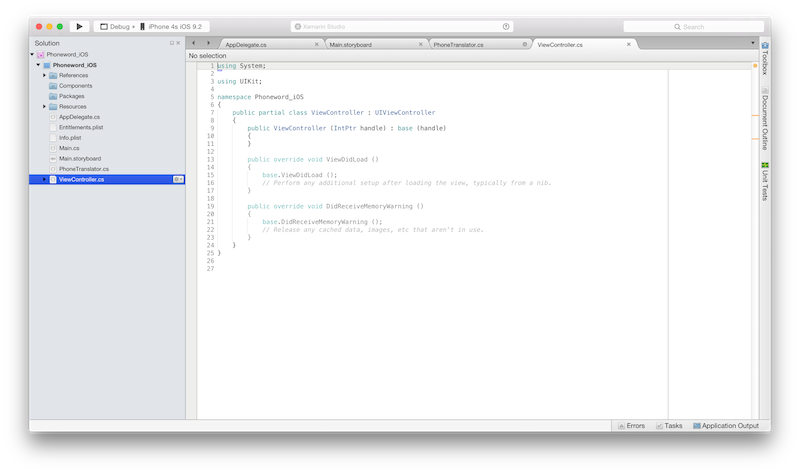
Begin by wiring up the
TranslateButton. In the ViewController class, find theViewDidLoadmethod and add the following code beneath thebase.ViewDidLoad()call:string translatedNumber = ""; TranslateButton.TouchUpInside += (object sender, EventArgs e) => { // Convert the phone number with text to a number // using PhoneTranslator.cs translatedNumber = PhoneTranslator.ToNumber( PhoneNumberText.Text); // Dismiss the keyboard if text field was tapped PhoneNumberText.ResignFirstResponder (); if (translatedNumber == "") { CallButton.SetTitle ("Call ", UIControlState.Normal); CallButton.Enabled = false; } else { CallButton.SetTitle ("Call " + translatedNumber, UIControlState.Normal); CallButton.Enabled = true; } };Include
using Phoneword_iOS;if the file's namespace is different.Add code to respond to the user pressing the second button, which is named
CallButton. Place the following code below the code for theTranslateButtonand addusing Foundation;to the top of the file:CallButton.TouchUpInside += (object sender, EventArgs e) => { // Use URL handler with tel: prefix to invoke Apple's Phone app... var url = new NSUrl ("tel:" + translatedNumber); // ...otherwise show an alert dialog if (!UIApplication.SharedApplication.OpenUrl (url)) { var alert = UIAlertController.Create ("Not supported", "Scheme 'tel:' is not supported on this device", UIAlertControllerStyle.Alert); alert.AddAction (UIAlertAction.Create ("Ok", UIAlertActionStyle.Default, null)); PresentViewController (alert, true, null); } };Save the changes and then build the application by choosing Build > Build All or pressing ⌘ + B. If the application compiles, a success message will appear at the top of the IDE:

If there are errors, go through the previous steps and correct any mistakes until the application builds successfully.
Finally, test the application in the iOS Simulator. In the top left of the IDE, choose Debug from the first dropdown, and iPhone XR iOS 12.0 (or other available simulator) from the second dropdown, and press Start (the triangular button that resembles a Play button):

Note
At present, due to a requirement from Apple, it may be necessary to have a development certificate or signing identity to build you code for device or simulator. Follow the steps in the Device Provisioning guide to set this up.
This will launch the application inside the iOS Simulator:

Phone calls are not supported in the iOS Simulator; instead, you will see an alert dialog when trying to place a call:

Visual Studio Walkthrough
This walkthrough describes how to create an application called Phoneword that translates an alphanumeric phone number into a numeric phone number.
Note
This walkthrough uses Visual Studio Enterprise 2017 on a Windows 10 Virtual Machine. Your set up can differ from this, as long as it meets the requirements above, but be aware that some screenshots may look different to your set up.
Note
Before proceeding with this walkthrough, you must have already connected to your Mac from Visual Studio. This is because Xamarin.iOS relies on Apple's tooling to build and launch applications. To get set up, follow the steps in the Pair to Mac guide.
Launch Visual Studio from the Start menu:
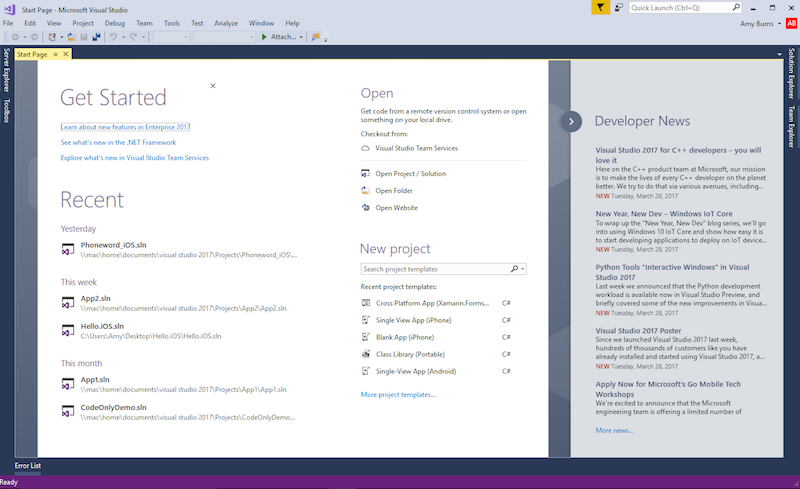
Create a new Xamarin.iOS solution by selecting File > New > Project... > Visual C# > iPhone & iPad > iOS App (Xamarin):
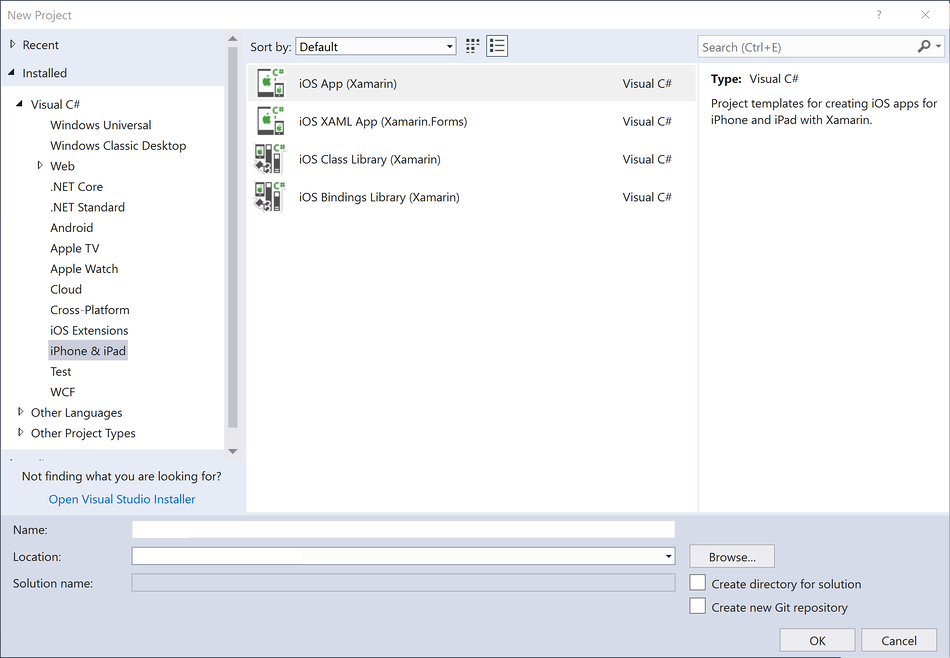
In the next dialog that appears, select the Single View App template and press OK to create the project:
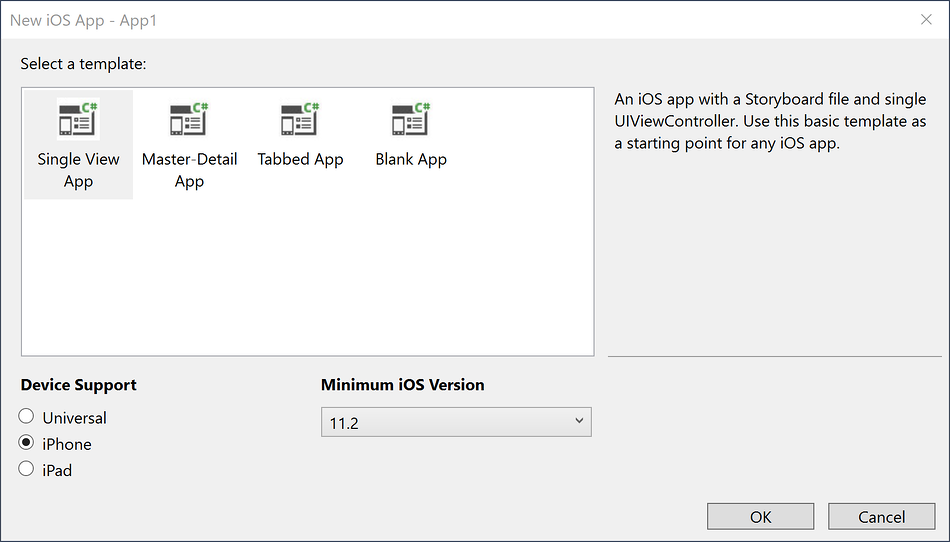
Confirm that the Xamarin Mac Agent icon in the toolbar is green.

If it isn't, this means that there is no connection to your Mac build host, follow the steps in the configuration guide to get connected.
Open the Main.storyboard file in the iOS Designer by double-clicking on it in the Solution Explorer:
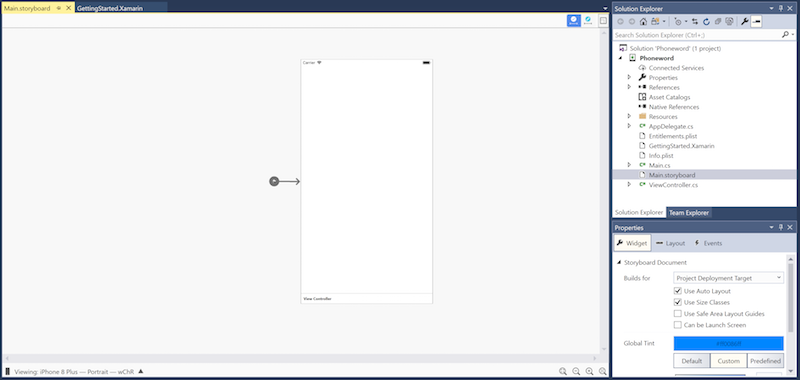
Open the Toolbox tab, type “label” into the search bar and drag a Label onto the design surface (the area in the center):
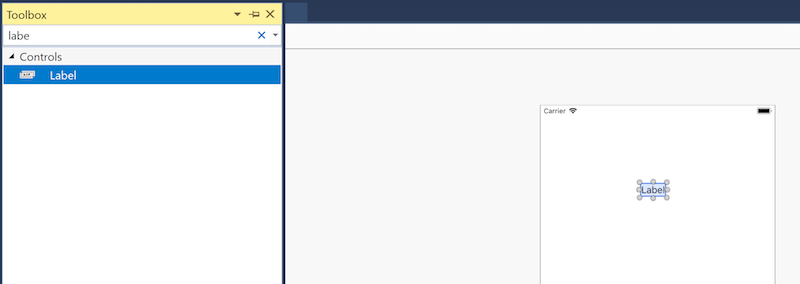
Next, grab the handles of the Dragging Controls and make the label wider:
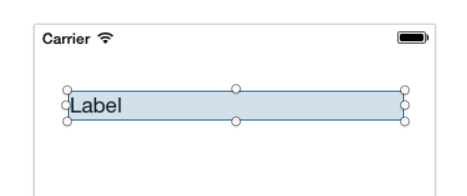
With the Label selected on the design surface, use the Properties Windows to change the Text property of the Label to "Enter a Phoneword:"

Note
You can bring up the Properties or Toolbox at any time by navigating to the View menu.
Search for “text field” inside the Toolbox and drag a Text Field from the Toolbox onto the design surface and place it under the Label. Adjust the width until the Text Field is the same width as the Label:
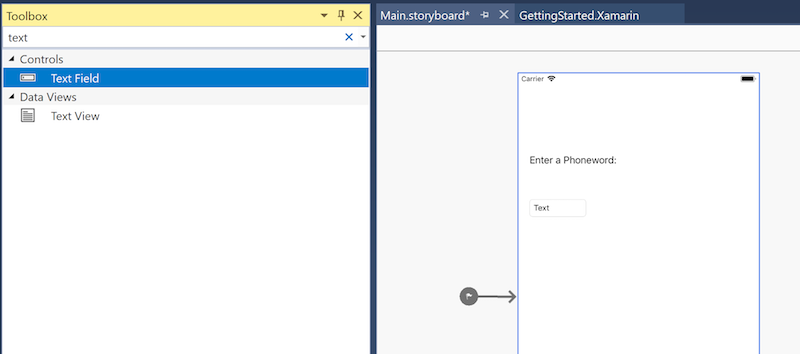
With the Text Field selected on the design surface, change the Text Field’s Name property in the Identity section of the Properties to
PhoneNumberText, and change the Text property to "1-855-XAMARIN":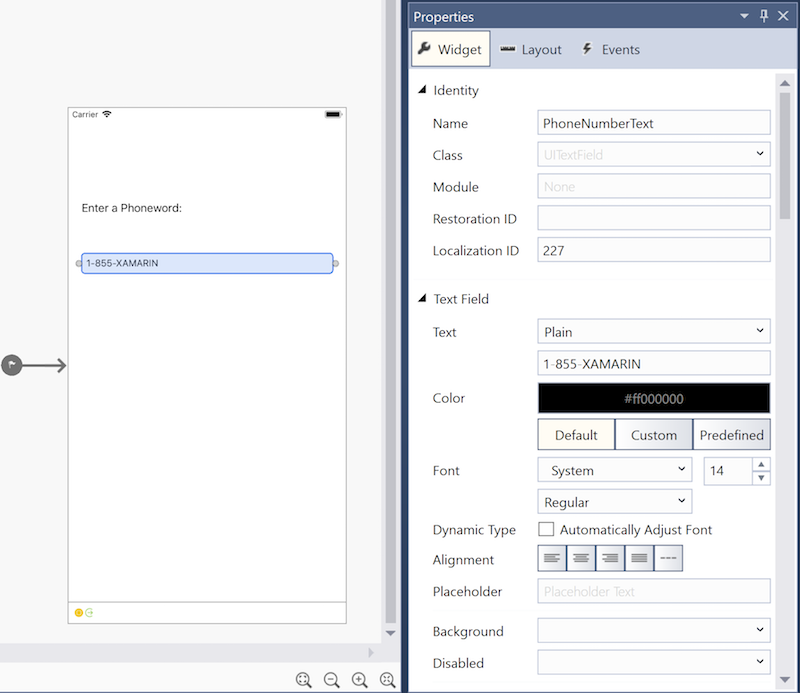
Drag a Button from the Toolbox onto the design surface and place it under the Text Field. Adjust the width so the Button is as wide as the Text Field and Label:
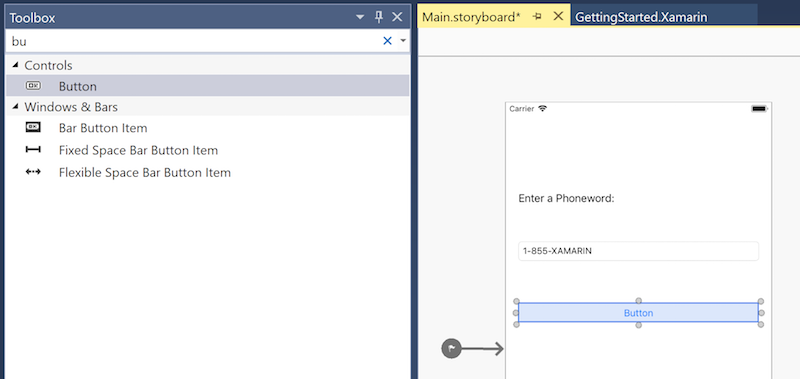
With the Button selected on the design surface, change the Name property in the Identity section of the Properties to
TranslateButton. Change the Title property to "Translate":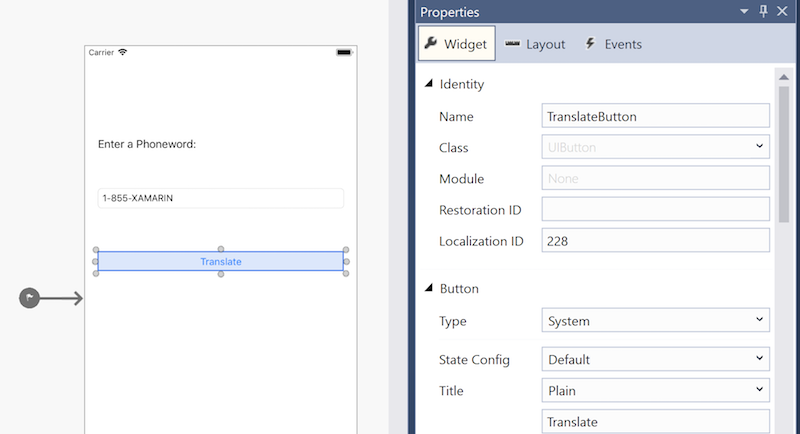
Repeat the previous two steps and drag a Button from the Toolbox onto the design surface and place it under the first Button. Adjust the width so the Button is as wide as the first Button:
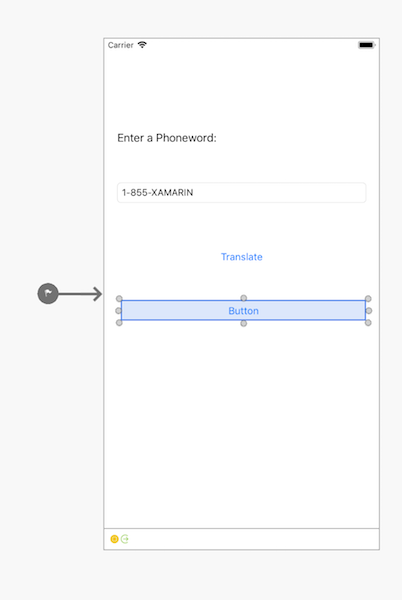
With the second Button selected on the design surface, change the Name property in the Identity section of the Properties to
CallButton. Change the Title property to "Call":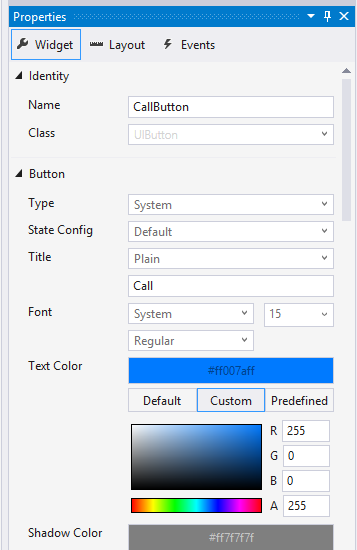
Save the changes by navigating to File > Save All or by pressing Ctrl + s.
Add some code to translate phone numbers from alphanumeric to numeric. To do this, first add a new file to the Project by right-clicking on the Phoneword Project in the Solution Explorer and choosing Add > New Item... or pressing Ctrl + Shift + A:
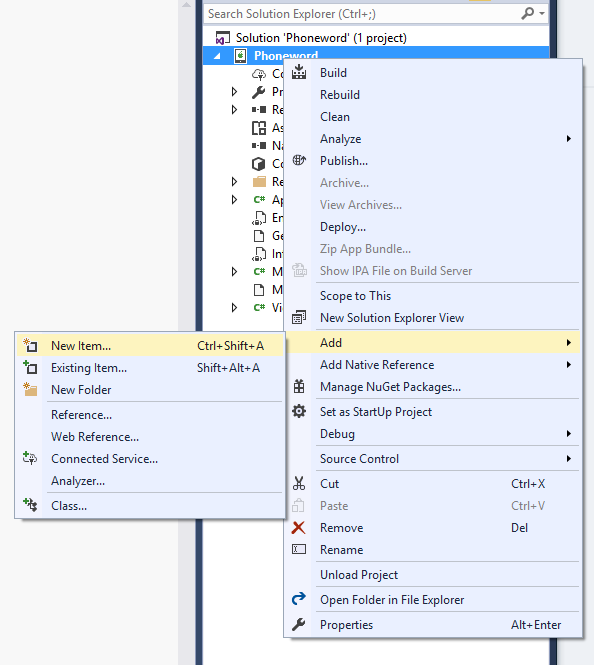
In the Add New Item dialog (right click on the project, choose Add > New Item...), select Apple > Class and name the new file
PhoneTranslator: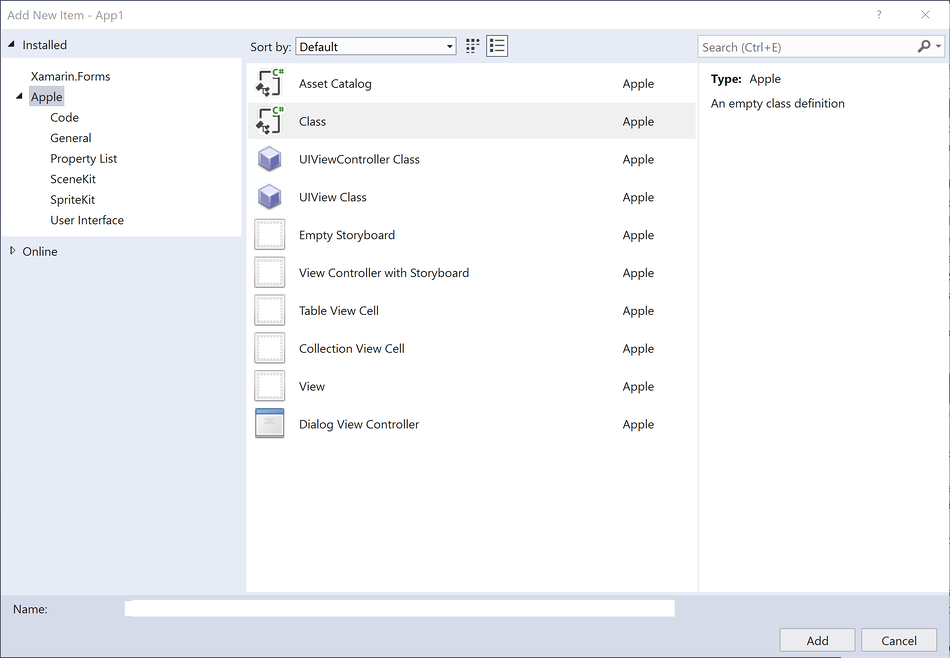
Important
Make sure that you select the 'class' template that has a C# in the icon. Otherwise you may not be able to reference this new class.
This creates a new C# class. Remove all the template code and replace it with the following code:
using System.Text; using System; namespace Phoneword { public static class PhoneTranslator { public static string ToNumber(string raw) { if (string.IsNullOrWhiteSpace(raw)) { return ""; } else { raw = raw.ToUpperInvariant(); } var newNumber = new StringBuilder(); foreach (var c in raw) { if (" -0123456789".Contains(c)) { newNumber.Append(c); } else { var result = TranslateToNumber(c); if (result != null) { newNumber.Append(result); } } // otherwise we've skipped a non-numeric char } return newNumber.ToString(); } static bool Contains (this string keyString, char c) { return keyString.IndexOf(c) >= 0; } static int? TranslateToNumber(char c) { if ("ABC".Contains(c)) { return 2; } else if ("DEF".Contains(c)) { return 3; } else if ("GHI".Contains(c)) { return 4; } else if ("JKL".Contains(c)) { return 5; } else if ("MNO".Contains(c)) { return 6; } else if ("PQRS".Contains(c)) { return 7; } else if ("TUV".Contains(c)) { return 8; } else if ("WXYZ".Contains(c)) { return 9; } return null; } } }Save the PhoneTranslator.cs file and close it.
Double-click on ViewController.cs in the Solution Explorer to open it, so that logic can be added to handles interactions with the buttons:
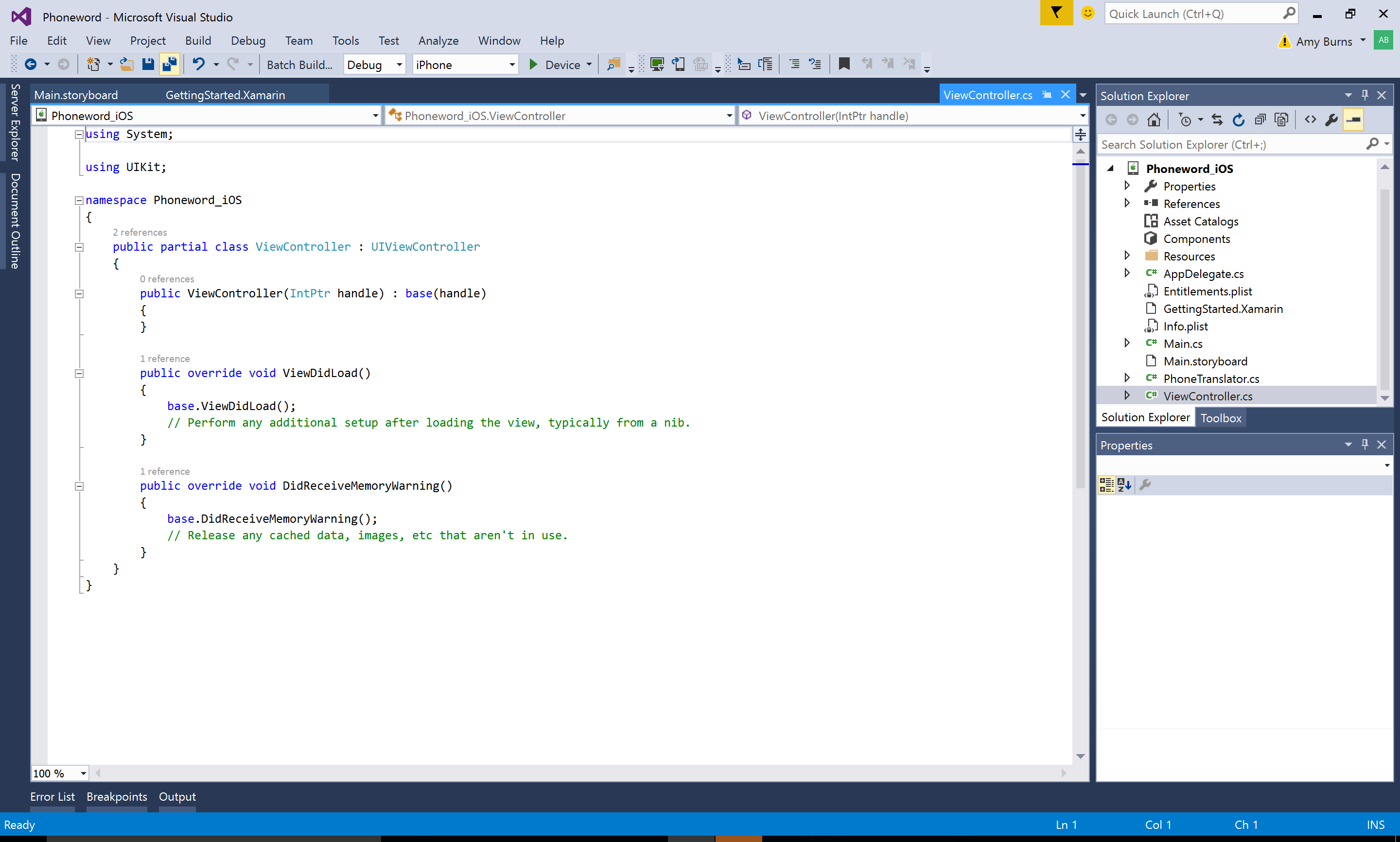
Begin by wiring up the
TranslateButton. In the ViewController class, find theViewDidLoadmethod. Add the following button code insideViewDidLoad, beneath thebase.ViewDidLoad()call:string translatedNumber = ""; TranslateButton.TouchUpInside += (object sender, EventArgs e) => { // Convert the phone number with text to a number // using PhoneTranslator.cs translatedNumber = PhoneTranslator.ToNumber(PhoneNumberText.Text); // Dismiss the keyboard if text field was tapped PhoneNumberText.ResignFirstResponder (); if (translatedNumber == "") { CallButton.SetTitle ("Call", UIControlState.Normal); CallButton.Enabled = false; } else { CallButton.SetTitle ("Call " + translatedNumber, UIControlState.Normal); CallButton.Enabled = true; } };Include
using Phoneword;if the file's namespace is different.Add code to respond to the user pressing the second button, which is named
CallButton. Place the following code below the code for theTranslateButtonand addusing Foundation;to the top of the file:CallButton.TouchUpInside += (object sender, EventArgs e) => { var url = new NSUrl ("tel:" + translatedNumber); // Use URL handler with tel: prefix to invoke Apple's Phone app, // otherwise show an alert dialog if (!UIApplication.SharedApplication.OpenUrl (url)) { var alert = UIAlertController.Create ("Not supported", "Scheme 'tel:' is not supported on this device", UIAlertControllerStyle.Alert); alert.AddAction (UIAlertAction.Create ("Ok", UIAlertActionStyle.Default, null)); PresentViewController (alert, true, null); } };Save the changes, and then build the application by choosing Build > Build Solution or pressing Ctrl + Shift + B. If the application compiles, a success message will appear at the bottom of the IDE:

If there are errors, go through the previous steps and correct any mistakes until the application builds successfully.
Finally, test the application in the Remoted iOS Simulator. In the IDE toolbar, choose Debug and iPhone 8 Plus iOS x.x from the drop down menus, and press Start (the green triangle that resembles a Play button):
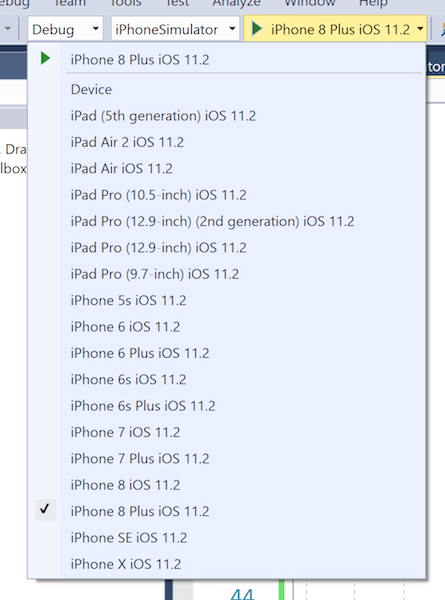
This will launch the application inside the iOS Simulator:
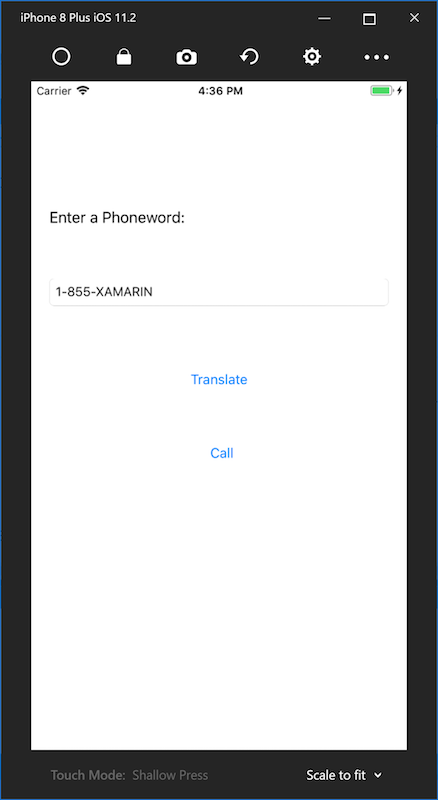
Phone calls are not supported in the iOS Simulator; instead, an alert dialog will display when trying to place a call:
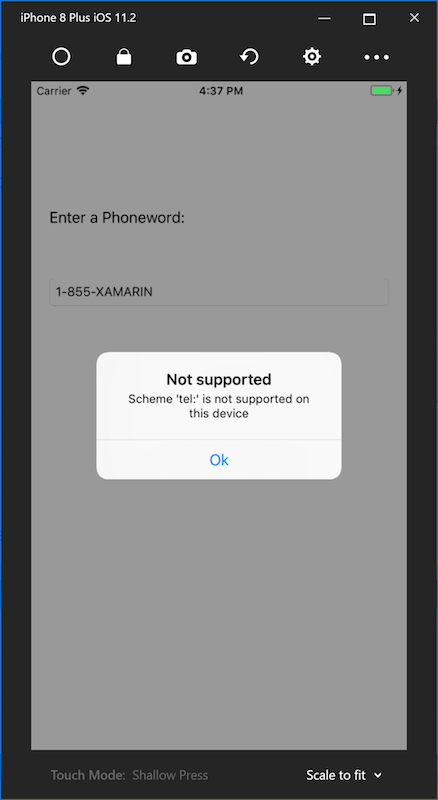
Congratulations on completing your first Xamarin.iOS application!
Now it’s time to dissect the tools and skills shown in this guide in the Hello, iOS Deep Dive.
